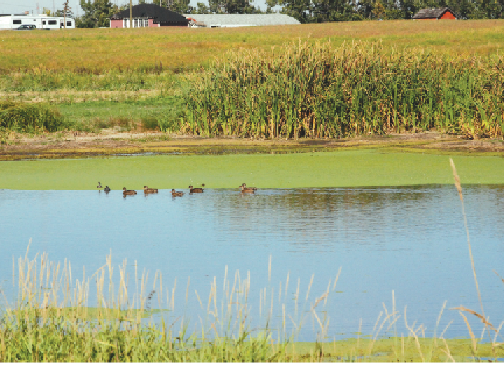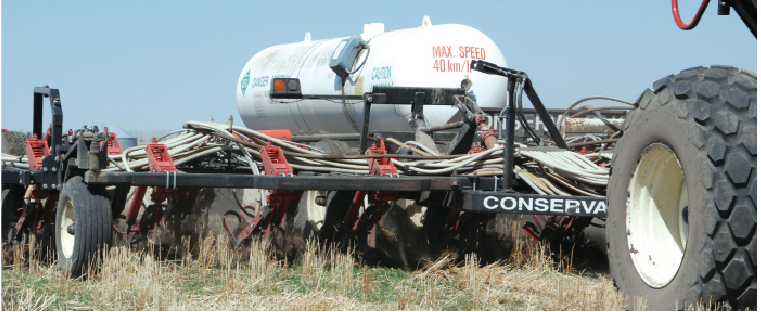
Features
Agronomy
Tillage
Zero-till study shows $200-million benefit in Alberta
Across Western Canada, the number of acres under zero or no-till operations continues to increase, and Alberta is no exception. According to Statistics Canada, the no-till farming acreage in Alberta rose to nine million acres in 2006 up from 0.6 million acres in 1991, an increase of 1358 percent. That number is expected to expand to more than 12 million acres by 2011 as farmers continue to realize the value and benefits of no-till systems.
September 21, 2010 By Donna Fleury

|
|
| Some US studies have put a wildlife enhancement value to a hunter at $300 per acre. Photos courtesy of Bruce Barker.
|
Across Western Canada, the number of acres under zero or no-till operations continues to increase, and Alberta is no exception. According to Statistics Canada, the no-till farming acreage in Alberta rose to nine million acres in 2006 up from 0.6 million acres in 1991, an increase of 1358 percent. That number is expected to expand to more than 12 million acres by 2011 as farmers continue to realize the value and benefits of no-till systems.
In 2009, the Alberta Reduced Tillage Linkages (RTL), in collaboration with Dr. Mirza Baig of Consulting Options in Edmonton, decided to try to summarize all of the economic, environmental and agronomic benefits of no-till in Western Canada, with a special emphasis on Alberta. Their research showed that, on nine million acres, a conservative estimate of the total value of no-till for Albertans was more than $200 million. However, the combination of environmental, economic and agronomic values adds up to far more than the dollar value, as many of the environmental and landscape improvements cannot easily be measured.
Using Statistics Canada research and survey data, RTL estimated what farmers either saved or gained on the 8,950,836 acres they direct-seeded in 2006. To reflect the rising cost of fuel and labour, the increased value of crops, and the introduction of a carbon market in Alberta, 2008 values were applied to the 2006 acres data. They also have tried to look at other benefits such as soil erosion prevention, moisture management, environmental goods and soil quality, and factors that provide a return to society such as CO2 reductions. “Moving to zero-till improves the physical, chemical and biological properties of the soil, and provides substantial savings on fuel, farm machinery-life and labor costs,” explains Baig. “There are many other important agronomic and environmental benefits that are difficult to measure and quantify.”

|
|
| Direct seeding has added at least $200 million dollars to the Alberta economy.
|
For example, factors such as wildlife enhancement, environmental goods and services and climate change need additional research. “One of the biggest benefits of moving to zero-till is the substantial improvement in organic matter and improved yields,” says Baig. “Reduced tillage makes the biggest difference under dry conditions or where moisture is a limiting factor. For example, in 2003 and 2009, fields under reduced tillage in areas of drought conditions showed the biggest differences in yields and in some cases, whether farmers actually got a crop or not.”
With the early season dry conditions in 2010, reduced tillage could prove a big advantage in many areas this year. The study conservatively estimated that no-till increases crop yields by an average of two bushels per acre. “The fuel savings under zero-till operations is considerable,” says Baig. “No-till farming operations use up to 80 percent less fuel as compared to conventional tillage.”
The study estimates a fuel savings of at least six litres per acre for zero-till operations, and likely more than that in a lot of operations. That is equivalent to a savings of 53,705,016 litres on nine million acres. The fuel savings also translate into emissions reductions of 2.7 kg of CO2 per litre of fuel burned or 145,004 tonnes, which is equivalent to removing 26,556 cars from the road. “Another significant saving for zero-till operations is labour or time,” explains Baig. No-till systems generally require one or two trips over fields compared with five or six trips with conventional tillage, a huge savings in time, labour and farm machinery-life. The study shows this adds up to a time saving of 15.7 minutes per acre, or more than 2.3 million hours saved. Using an estimate of $15 per acre for labour in 2008, that is a savings of $35,132,025. Baig adds that for an average farm size of 1500 to 2000 acres, that is about 500 hours or a week or more of time saved by switching to a no-till system. This is time farmers can use for farm expansion or other opportunities.
RTL also tried to put a value on the amount of carbon sequestered in the soil, based on protocols developed for the carbon trading market in Alberta. The amount of carbon sequestered, expressed as carbon dioxide equivalent
(CO2e), was calculated to be 0.145 tonnes per acre or a total of 1,297,871 tonnes. Using a 2008 estimated emitter price of CO2e of $8.50 per tonne, it equals a return of $11,031,903. The estimated $5 per tonne return to the farmer is $6,489,355.
With no-till systems, one of the longer-term benefits is the improvement in soil quality and increase in organic matter. Although there is not any available data to show specifics, some farmers who have been in no-till systems for a long time are finding big improvements in soil quality that enable them to reduce some of their fertilizer inputs under some conditions. “There are many other environmental benefits that are difficult to quantify,” says Baig. “Many zero-till farmers comment they are seeing more birds and more wildlife in their fields. Some studies in the US have put a wildlife enhancement value to a hunter at $300 per acre. However, we currently don’t have any similar data or estimates here.”
The economic benefits of zero-till will be realized over time in an operation. “The improvements from direct seeding develop over time,” says Baig. “Some of the factors that continue to make zero-till successful are big advancements in machinery and seed placement technologies, lower costs for glyphosate and access to excellent research and extension information.”
Overall, the study estimates the value of direct seeding to Alberta farmers, including fuel and labour savings, increased yield and carbon value, to total $204,347,554. Along with the economic benefits, soil and moisture improvements, and other wildlife and environmental benefits, the number of acres of zero-till is expected to continue to increase in Western Canada.